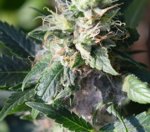

If you live in Michigan, I’m sure you have an idea of what a wet basement smells like: a mix of wet dog, dirt and overall gross dankness. This can be a telltale sign of mold and other potentially harmful issues. Moldy weed poses a health risk for all that are exposed to it, not just smokers. Reactions can be similar to allergies: coughing, wheezing, shortness of breath, chest tightness, stuffy nose, itchy eyes and fever. Long-term mold exposure can also cause lethargy and memory loss and can be deadly for those who have a compromised immune system.
Moldy weed can appear in multiple forms. The most common is powdered mildew, which gives buds a dusty appearance. Powdered mildew shows up first on the large fan leaves of the cannabis plant and evolves into white, fuzzy spots that halt the plant’s growth. Full-blown cases crest a thick, white mildew that covers the entirety of the plant. To combat this, some folks use potassium bicarbonate, similar to baking soda, as a contact fungicide to quickly kill off spots.
Botrytis, otherwise known as “bud rot,” is a less smelly form of mold that wilts the cannabis bud. To me, weed buds that have been infected with botrytis look like the inside of a rotten apple: brown and slightly squishy. These brown spots eventually turn into dry, white, cotton ball-looking patches that render the bud unusable. One natural way to prevent bud rot is to drop essential oils with antifungal properties, like lemongrass, eucalyptus or peppermint, into a spray bottle with water and lightly spray the plant.
Wilted leaves could also be the sign of the third most common type of cannabis mold, fusarium, which starts in the soil and rots the plant’s roots, disrupting the absorption of nutrients to the rest of the plant. Roots become red and the stem may swell, break open, wilt and collapse. Unfortunately, once root rot sets in, there aren’t many fixes beyond trashing the plant to prevent an outbreak.
Mold can wipe out an entire cannabis crop if not addressed quickly, but there are ways to minimize, or even prevent, mold growth. Growers should regularly monitor the humidity levels of their grow rooms throughout the plant’s life cycle. The humidity should start around 70% to 80% during the plant’s seedling phase and decline as the plant reaches adulthood. Proper air circulation is also crucial to help each plant dry out properly after harvest. Airflow can be improved by defoliating, or removing, the large fan leaves off the cannabis plant after harvest. Although steps can be taken to prevent mold in the growing stages, sometimes it may slip through. If caught early enough, you can save your crop by isolating the infected plant and removing the gross stuff. Just make sure to properly sterilize your tools afterward to avoid spreading mold spores.
If you are new to growing cannabis, it may help to seek out specific strains that are known to be more mold-resistant. Landrace strains like Durban Poison, Afghan Kush, and Strawberry Cough are indigenous to certain regions of the world with harsher climates. By adapting to those conditions, the weed becomes more hardy and resistant to mold. Neem oil, a natural pesticide used to kill a variety of insects and fungal diseases, can also be used during the growing stages to help prevent any surprises (or, should I say, spore-rises?). You can acquire neem oil at just about any plant store, but I recommend checking out some of Lansing’s locally owned grow stores like GrowGeneration.
Whether you grow it yourself or buy it in bulk, how you store your weed is also important. Keep cannabis in a cool, dry place. This is where “stash jars,” airtight containers that assure your weed stays properly dry, come into play. You can also purchase disposable humidity packs for your jars if you want complete peace of mind. Boveda, a popular brand, can be found on Amazon, in grow stores and even in some dispensaries. If you purchase prepacked flower and come across a moldy bud, put it back in the container and contact the dispensary you purchased it from. Some will allow you to exchange it or offer a credit.
Support City Pulse - Donate Today!
Comments
No comments on this item Please log in to comment by clicking here